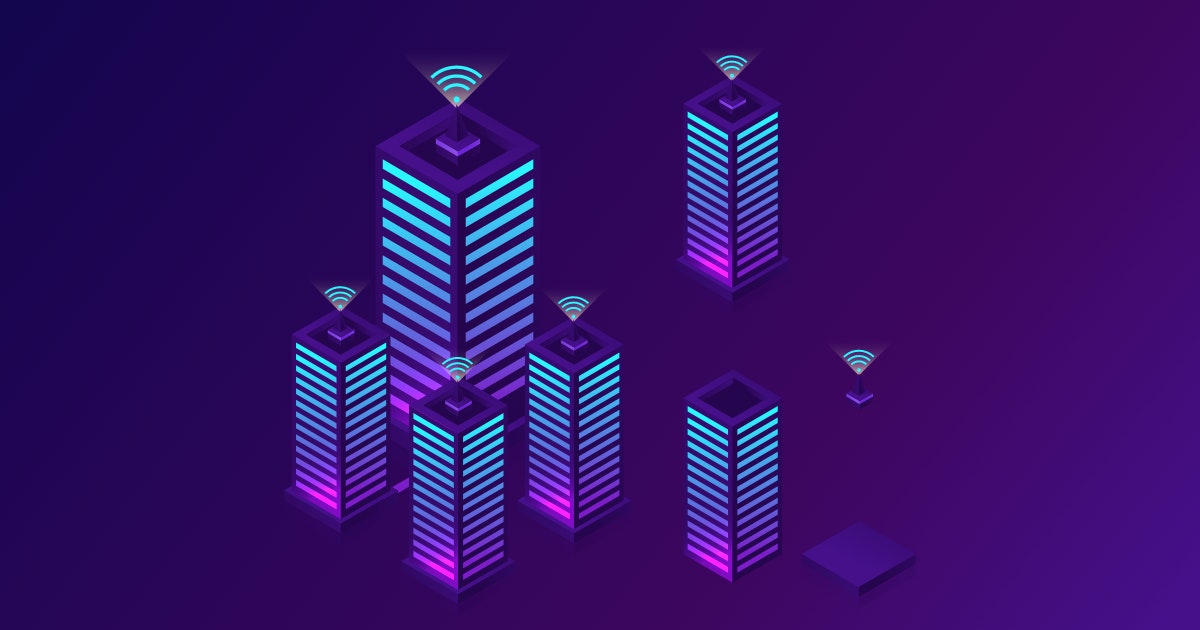Table of Content
The maintenance of buildings is heading to a future where machines do much more than humans and for a good reason.
A worker monitoring all systems in an office building or factory floor is soon becoming inadequate with the rising need for physical security and maintenance. They demand proactive maintenance methods due to the complexity of the structures.
In a nutshell, facility management strategies once driven by human oversight need to undergo digital transformation. That is where IoT can make a difference.
Machine sensors integrated into major components like boilers or HVAC units automate the facilities management process, making the buildings smarter.
They free up your workforce, allowing them to focus on other tasks while monitoring different systems for optimum efficiency.
What is IoT for facility management?
It is a transformative approach that leverages interconnected devices and sensors to create intelligent, efficient, and responsive building environments. This technology integrates various building systems - such as HVAC, lighting, security, and maintenance - into a cohesive network that can be monitored and controlled centrally.
By collecting and analyzing real-time data from throughout the building, IoT enables facility managers to optimize energy usage, improve space utilization, predict maintenance needs, and enhance occupant comfort.
This results in significant cost savings, improved sustainability, and a better overall experience for building users. It turns regular buildings into "smart" buildings that can adjust and respond to what's happening inside them in real time.
Optimize Your Facility Operations with IoT Integration!
Explore SolutionsTop trends in IoT-enabled facility management
Digital transformation of facilities is thus helpful in improving the quality, security, production rates, and longevity of physical assets. Technology trends impacting and improving facility management solutions are:
1. Virtual reality (VR) and Augmented Reality (AR)
Virtual and augmented reality revolutionize facility management by enabling immersive training and remote maintenance. Technicians can use AR glasses to overlay instructions on machinery or visualize building layouts. For example, VR can simulate emergency scenarios for staff training, improving response times and safety protocols.
2. Advanced HVAC technology
Advanced HVAC systems equipped with IoT sensors optimize climate control, enhancing energy efficiency and occupant comfort. Smart thermostats and predictive maintenance reduce costs and downtime. For instance, AI-driven HVAC can automatically adjust settings based on occupancy, ensuring optimal conditions without manual intervention.
3. Machine Learning (ML) and Artificial Intelligence (AI)
ML and AI algorithms analyze vast amounts of data to predict maintenance needs and optimize operations. AI-driven analytics can forecast equipment failures and suggest proactive measures. For example, AI can monitor energy usage patterns to recommend adjustments, reducing waste and operational costs.
4. IoT-enabled smart buildings
IoT-enabled smart buildings integrate sensors and automation to enhance energy efficiency, security, and occupant comfort. These buildings can adjust lighting, heating, and security systems in real time. For instance, smart lighting systems can dim or brighten based on natural light availability, reducing energy consumption.
5. Employee Experience (EX) apps
EX apps enhance workplace efficiency by integrating IoT data to personalize the employee experience. These apps can manage room bookings, adjust personal workspace settings, and provide real-time facility updates. Employees can use apps to find available meeting rooms or adjust their desk's lighting and temperature.
6. Wearable IoT equipment
Wearable IoT devices monitor worker health and safety in real time. These devices can track vital signs, detect hazardous conditions, and provide emergency alerts. Let's say, smart helmets can monitor fatigue levels and environmental conditions, ensuring workers' safety on construction sites.
7. Drones for facility condition assessments
Drones equipped with cameras and sensors conduct facility inspections, accessing hard-to-reach areas and providing detailed data. They can identify structural issues, monitor construction progress, and inspect rooftops. For instance, drones can quickly survey large facilities for damage after severe weather events, speeding up the assessment process.
8. Browser-based facility management system
Browser-based systems offer flexibility and accessibility for managing facilities. These platforms enable remote monitoring, maintenance scheduling, and real-time data analysis from any location. For example, facility managers can access and control building systems from their smartphones, streamlining operations and decision-making.
9. Facility optimization with ML
ML-driven optimization analyzes data from various sources to enhance facility performance. These algorithms can optimize energy usage, predict maintenance needs, and improve space utilization. For example, ML can analyze occupancy patterns to suggest layout changes that maximize space efficiency and reduce operational costs.
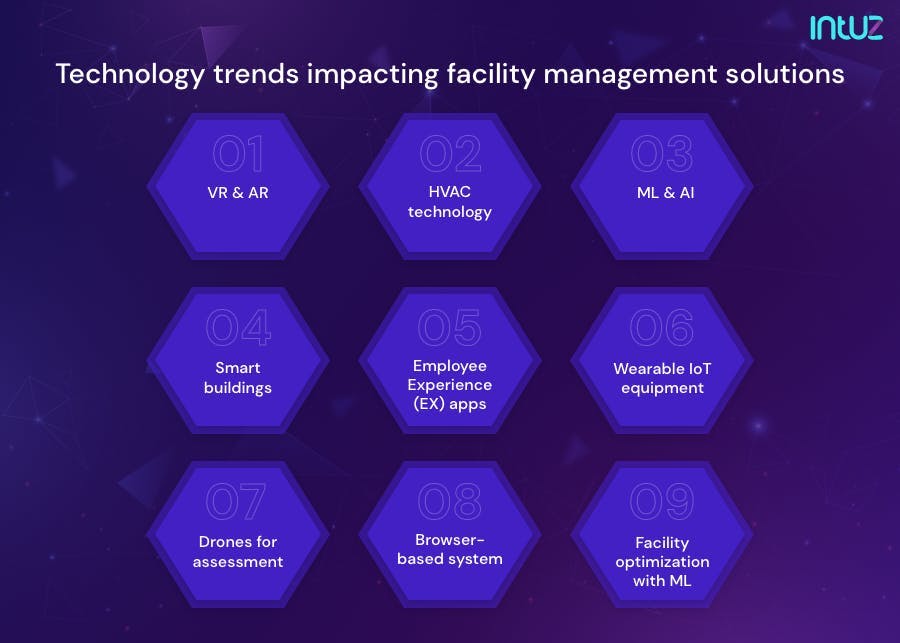
Top 8 IoT applications in facility management
Believe it or not — facility management companies can add value and increase profit margins by deploying IoT solutions. The latter helps reduce operating costs, expanding their scope and increasing added value services.
Unfortunately, traditional Building Management Systems (BMS) cannot offer the data in real-time that is required from managers to make well-informed decisions concerning efficiency, staff productivity, and comfort.
IoT can be defined as connected sensor networks and computing embedded in physical objects — going from pacemakers to thermostats — linked through internet connectivity. Naturally, they have a role to play in facility management in this day and age. Let us explore:
1. Embedded sensors in devices and buildings
Embedded sensors deployed throughout a building help optimize energy usage and attain carbon neutrality for business owners. Smart devices can be connected to monitor various aspects, such as HVAC solutions or lights within a building to keep energy waste to a minimum.
Connectivity through wireless networks allows them to communicate among themselves. They help keep track of critical assets and monitor activity across the building. Environmental sensors embedded at entrances keep track of visitors and help with security maintenance.
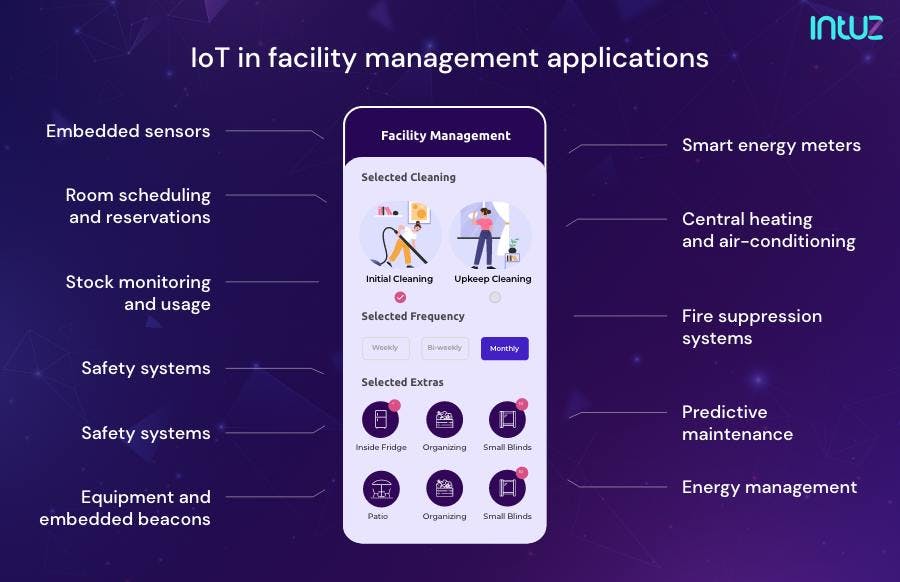
2. Room scheduling and reservations
An important application of IoT is room reservation systems which help in optimizing indoor spaces. Intelligent scheduling tools called occupancy management systems to allow employees to see which rooms are booked or available in real-time through a visual floor plan.
It even provides employers an accurate overview of the workplace and how it may be utilized more efficiently.
3. Stock monitoring and usage
Companies can get a more comprehensive view of their assets and inventory than earlier. It helps them meet Service-Level Agreements (SLAs) and ensure customer trust. It also increases the efficiency of logistics managers, allowing them to perform well with limited resources.
They can maintain an accurate stock count across various departments through innovative solutions like NFC tags or QR Codes placed strategically throughout the stores.
4. Safety systems
Despite the concerns and debate worldwide, IoT is a game-changer for safety and security. It helps to monitor smoke detectors, alarms, and other life-safety systems remotely over the internet rather conveniently.
The applications gather real-time data from sensors and pass on information about emergencies to the controllers. It is primarily helpful for manufacturing plants or high-risk environments, such as hospitals where lives depend on timely responses from their staff members.
IoT systems help ensure maximum efficiency with minimum human response times by automating processes. Companies can take a big sigh of relief in the facility management ecosystem without worrying about the security aspect.
5. Data storage
Cloud-based facility management software enables data aggregation and analysis while providing the highest level of security. It comes with minimal deployment and operating costs and a customized user experience based on the requirement of facilities managers.
The service provider manages the upkeep and maintenance of these systems. It is mainly covered in your subscription costs.
Facilities managers also get the flexibility to widen the network of IoT sensors and their types and enhance their performance through advanced techniques of Machine Learning and Artificial Intelligence. This was not possible in the traditional scheme of things.
6. Equipment and embedded beacons
Beacons are convenient, cost-effective ways to instantly communicate with employees across the facility. They are most often used by facility managers to send messages such as an alert, a warning, or even communicate the location of something in the facility.
Beacon technology has been around since Bluetooth was first created more than a decade ago. They are now being used in a variety of ways to improve day-to-day management.
The digital technologies can track an employee's location, monitor machinery performance, equipment condition, and authenticate visitors — making life easy for facility managers.
The beacon technology provides an efficient way by which managers can keep a tab on the performance of all components of the business model and ensure high degrees of security at their facilities. Who would have thought that beacons could come in handy in this day and age?
7. Smart energy meters
These are a great way to save money and time for facilities. Water and gas leaks can be detected quicker with these meters. This helps reduce loss due to inefficiencies and wastage of resources. It also helps save maintenance costs and losses due to downtime.
IoT data integration systems automate the process of entering and analyzing information. It helps facility managers monitor and estimates the overall consumption of resources.
8. Central heating and air-conditioning
With energy-efficient technologies for smart buildings, it is now possible for organizations of all sizes and in every sector to reduce their carbon footprint.
IoT development boards analyze the working of HVAC systems and other significant power draws at the facility — such as lights or computers used by staff members throughout the day.
It provides data analytics to help managers see precisely where the unnecessary use of resources can be curbed. You can take care of the environment while also saving money for your facility's maintenance process.
9. Fire suppression systems
Internet of Things-enabled heat-resistant temperature sensors can detect fires before they emit any harmful smoke or ash. They also calculate the intensity and predict the spread of fire, giving firefighters an idea of the measures they should take to control it.
Sensors could also tell them the possible sources of water nearby, and all necessary resources can be deployed quickly to combat blazes efficiently.
Integrating a voice alarm system could also help evacuate employees by guiding them through the best escape routes. The data collected by the sensors can be used to track the spread of fire within the facility.
10. Remote monitoring of facilities via predictive maintenance
With the increasing emphasis on personnel safety, organizations need alternative solutions that allow staff to examine assets without being physically present in extreme environments.
Typically, facility managers and their teams working in industries like oil and gas can relate to these constraints. That is why they are now deploying IoT-enabled monitoring for predictive maintenance, ensuring a safer work environment.
Due to the production, potential failures or any major incidents can be avoided. The preventive measures keep the equipment from breaking down and will help prevent costly repairs.
11. Energy management for facility managers
Sensors are being embedded in buildings to monitor and manage energy consumption. Some facilities have already cut their costs by up to 30% with the help of IoT technology.
Managers can analyze the usage of HVAC systems, lights, doors, and windows to understand and optimize energy consumption.
Benefits of IoT in smart building & facility management
By implementing IoT-based facility management, organizations can achieve substantial operational improvements, cost savings, and enhanced occupant satisfaction. These benefits underscore the transformative impact of IoT on modern facility management practices. let's explore each of them.
1. Boost efficiency using smart HVAC systems
IoT-based facility management significantly boosts operational efficiency by automating routine tasks and optimizing resource usage.
For example, a smart HVAC system can adjust heating and cooling based on occupancy and weather conditions, ensuring optimal comfort while reducing energy consumption.
This not only lowers utility bills but also extends the lifespan of the equipment by preventing overuse.
2. Prevent downtime with predictive maintenance
Predictive maintenance, powered by IoT sensors, minimizes unexpected downtime and costly repairs. For instance, vibration sensors on industrial machinery can detect early signs of wear and tear, alerting maintenance teams before a failure occurs.
This proactive approach ensures continuous operation, improves safety, and reduces maintenance costs by addressing issues early.
3. Save cost with smarter energy management
IoT devices enable precise monitoring and control of energy consumption. In a large commercial building, smart meters and sensors can track energy use in real time and identify areas of inefficiency. By integrating these systems with energy management software, facility managers can implement energy-saving strategies, such as dimming lights during peak sunlight hours or shutting down non-essential equipment when not in use, leading to significant cost savings and a reduced carbon footprint.
4. Enhanced security and safety
IoT-based security systems offer real-time surveillance and threat detection. For example, smart cameras with facial recognition can identify unauthorized personnel and send instant alerts to security teams. Integrated fire detection systems can also monitor smoke and temperature changes, triggering alarms and activating sprinklers automatically, ensuring a swift response to potential threats.
5. Better indoor air quality
Maintaining high indoor air quality is crucial for occupant health and productivity. IoT-enabled air quality monitors can continuously assess levels of pollutants, CO2, and humidity. In a school, for instance, these sensors can automatically adjust ventilation systems to ensure a healthy learning environment, reducing absenteeism and improving student performance.
6. Efficient water management
IoT solutions can track water usage and detect leaks in real time. In a hotel, smart water meters can identify unusual consumption patterns indicative of leaks or waste, allowing for prompt repairs. This not only conserves water but also reduces utility costs and prevents damage to the property.
7. Track assets effortlessly for better operations
IoT technology facilitates efficient tracking and management of assets. For example, in a hospital, RFID tags on medical equipment can provide real-time location data, ensuring critical devices are always available when needed. This reduces time spent searching for equipment, enhances workflow efficiency, and ensures timely maintenance.
Challenges in facility management
As any facility expands, so does the number of employees working in the area. Companies also need to spend more on things like space, maintenance, and equipment. But that also means more potential profit for facility management companies if they do their job right.
However, issues in any enterprise facilities management are unavoidable, but they demand fast solutions so that no harm comes to the facility or the personnel. Keeping that in mind, here are four challenges most commonly seen in facility management:
1. Real-time collaboration
Outdated facility management systems do not allow collaboration among teams resulting in miscommunication. This unfortunately causes increased resource waste and increases unnecessary costs.
Cloud computing and real-time tracking software make it possible for teams to collaborate and share data simultaneously. Reducing the delay in communication speeds up workflow. Managers are notified about changes instantly, and all their decisions are backed by data.
2. Maintenance of aging hardware
Keeping track of equipment wear and tear is a challenge for facility managers. The entire team has to face unexpected shutdowns if decisions on old equipment replacement are delayed. It lowers production efficiency and may reduce customer satisfaction rates as well.
Facility managers can use predictive analytics in facility management for real-time equipment condition tracking. IoT sensors monitor equipment and alert managers based on upcoming maintenance requirements based on historical data.
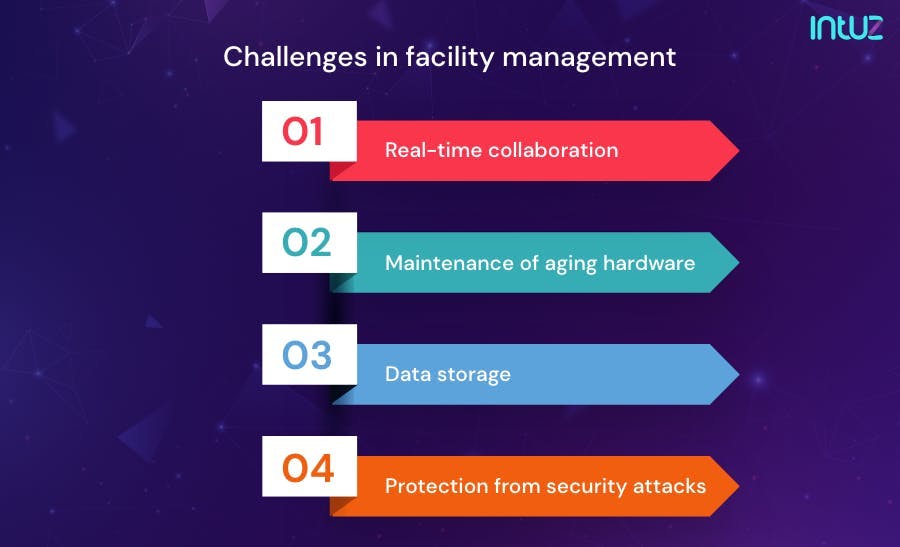
3. Data storage
Facility managers are often faced with the challenge of processing large volumes of information properly. They have to keep track of data and analyze it to make essential decisions to maintain the productivity of their facilities. They need to:
- Retrieve data efficiently to get quick access to vital information on resource consumption or labor management.
- Record data changes automatically and in real-time — It is much more efficient than manual data entry and supports informed decision-making.
- Ensure real-time data collection and information sharing — These are useful for sharing status updates and clearing miscommunication. Moreover, data plays a vital role in winning customer trust and coordinating with vendors.
- Meet data storage compliance requirements for legislative purposes.
4. Protection from security attacks
Suspicious activities in a facility must be tracked to ensure the safety of data and employees. Thanks to IoT, facility managers can enjoy the complete use of access control systems, but they may have to provide role-based permissions to their employees for smoother functioning.
In addition to login-password two-factor authentication, modern-day systems add a captcha test and other advanced security tools such as biometric technology to enhance the security of their facilities and avoid any cybercrimes.
These help facility managers to protect the facility against threats, like data leaks or intrusions, which can be a pretty expensive chore to settle.
IoT devices for facility management
Simply put, facility management is the management of physical systems, processes, and people in the built environment. It includes labor management, project management, maintenance, communication, emergency procedures, and response.
Naturally, given the scope of activities covered in facility management, it is imperative to use technology to support them. Here is a list of IoT devices that can be used for facility management conveniently:
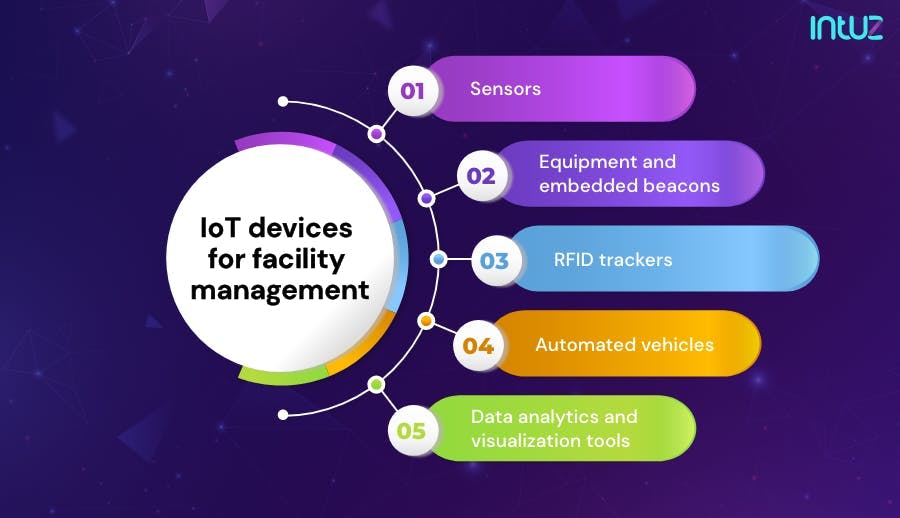
1. Sensors
Facility managers can monitor space usage and identify safety threats with IoT-powered sensors. Connected systems are triggered into action automatically, providing an additional layer of security for business owners.
Entry of unauthorized personnel can also be traced, and alarms can be raised in case of theft. You can enjoy peace of mind when it comes to protecting sensitive data during idle time as well.
By using environmental monitoring technologies and other types, such as motion detectors, you will be able to monitor the usage of floor space and other energy consumers, such as HVAC systems, computers, and lights.
Sensors also help detect sudden changes in humidity, pressure, gas, and temperature. They can detect fire, gas leaks, and other unusual working conditions to alert facility managers of any potential mishappening.
2. Equipment and embedded beacons
Beacons are small, wireless tools that can be used to track employees or machinery. They also act as a security measure for facility management activities, like monitoring assets and ensuring high levels of identification verification.
These tools run on Bluetooth and can be attached to assets to keep track of them. Following are the everyday use cases of beacons:
- Beacon on clothes: An employee's location can be tracked via Bluetooth connections by placing a beacon on their uniform. The data is exchanged between the beacon and a remote device that tracks their location conveniently.
It also ensures their safety by tracking changes in the environment around them. It helps facility managers avoid accidents by taking remedial action on time. These are especially useful for workers on an oil rig or those working near hazardous materials.
- Beacon on machinery: Beacon monitors state changes within specific categories, such as temperature sensors on oil pumps and level sensors in storage tanks. The information is shared in real time with operations and maintenance teams. They can keep track of leakages and overflows along with any servicing needs to save costs.
3. RFID trackers
Radio waves help easy and accurate tracking of objects and persons. RFID tags can be used to identify and trace movements across the facility. Beyond security purposes, it also acts as an access control tool to ensure accurate monitoring of visitors and assets. Real-time location tracking of inventory helps streamline the workflow across production floors.
4. Automated vehicles
Automated vehicles are a safe and innovative way to move items through the facility without the need for human supervision. Robust automated guided vehicles can conveniently move through crowded areas.
In addition, they can work for longer hours compared to humans and move large amounts of inventory with perfection. Automating monotonous tasks allows humans to engage in intellectually demanding activities.
Managers can improve the efficiency of their workforce while saving a lot of time on the floor. This was not possible until a few years ago!
5. Data analytics and visualization tools
Facility managers need data visualization tools to take advantage of the data captured by sensors and IoT devices. These analytics solutions process information and automatically generate visually rich reports that can help with monitoring employee performance in facilities.
They also generate resource usage patterns or occupancy rates for each area within the building. Preventive measures can also be defined and implemented by analyzing data through these visualization tools.
IoT in Smart Parking System - Problems, Solutions, Applications
Read NowOver to you
IoT is permeating every aspect of modern life, including facility management. The plethora of devices and sensors embedded in buildings offers new insights into how facilities are being used and what is happening with equipment at any given moment.
From room occupancy automation to smart energy management, these systems improve the efficiency of a facility. Data availability round the clock makes decision-making more accessible and faster.
Implementing IoT can help companies save money and provide a better experience for employees and customers alike.
Book a 45-minute free consultation with our IoT experts and get a free roadmap for integrating IoT to streamline facility management.
